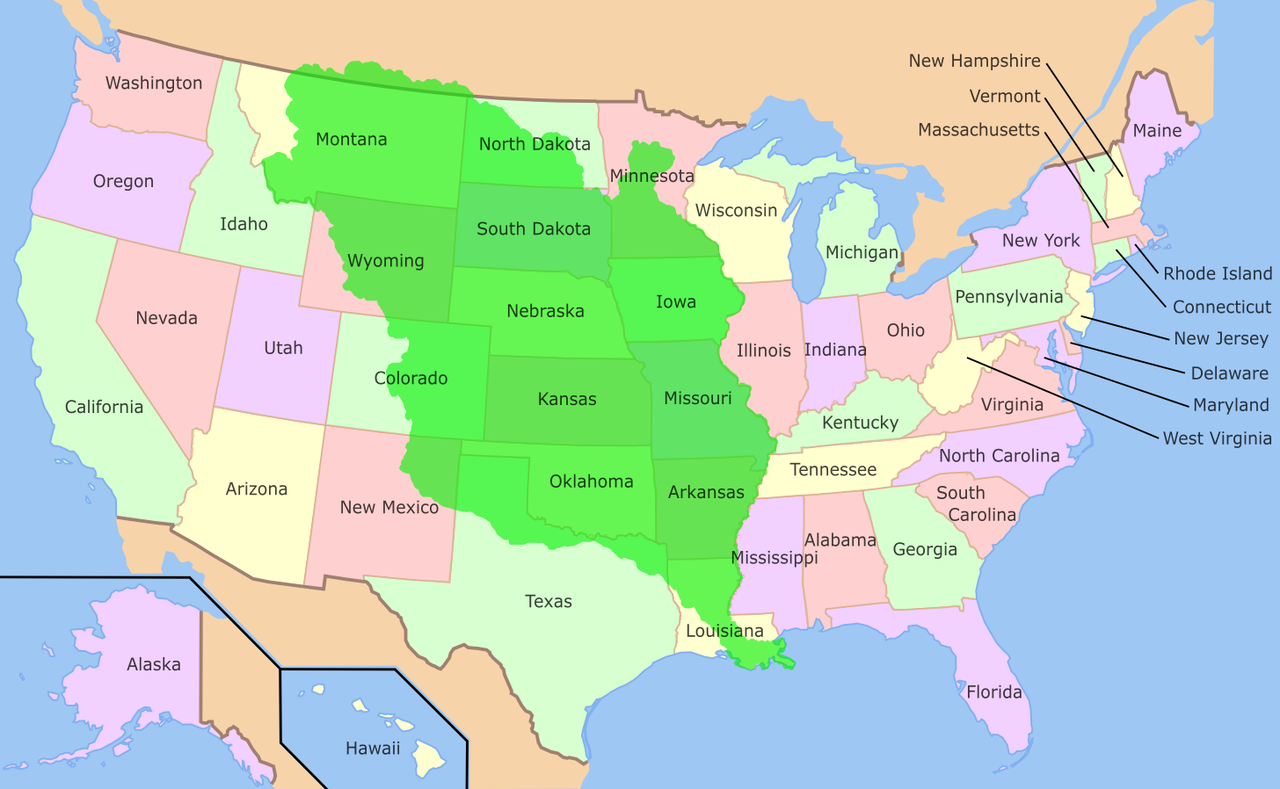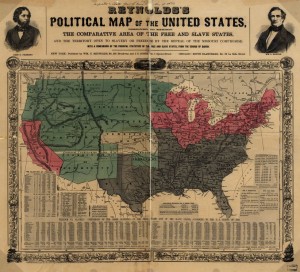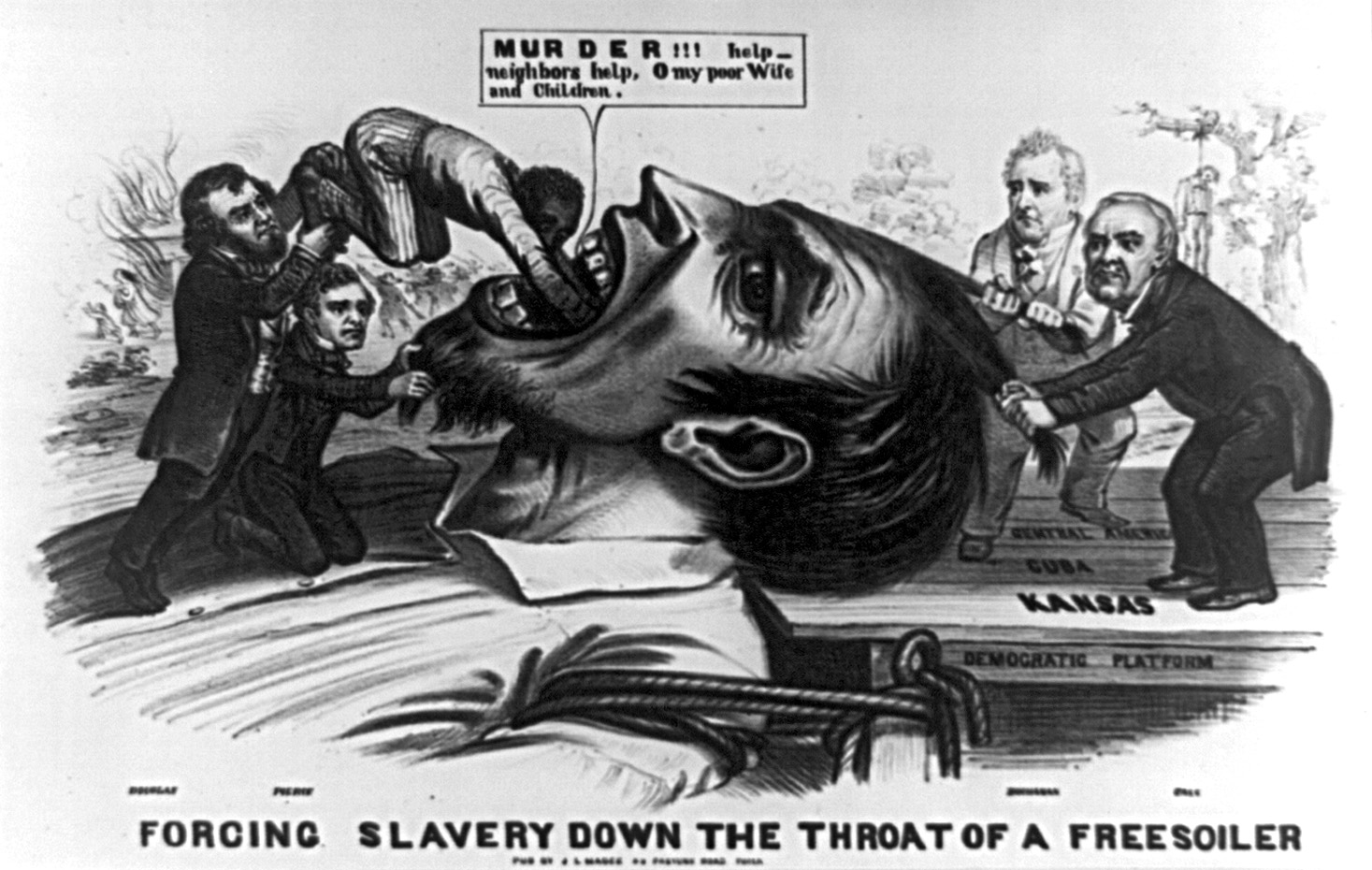It’s very common these days to hear claims that the US Civil War, often referred to by southerners as “The War of Northern Aggression,” was not in fact caused by a debate over slavery. It was, so modern apologists claim, a matter of states’ rights and resistance to the “tyranny” of the Federal government by southern states intent on maintaining a more decentralized system of government.
The latter represents a very contrived view of a very complex issue. A review of events leading up to the war makes it evident not only that the war’s direct cause was the slavery question, but that the “states’ rights” issue is largely fabrication.While there was considerable debate over the Federal issue, i.e. whether the central government should be strong or weak (the South generally favored a weak model), the use of “states’ rights” as an excuse for the war by modern apologists totally misses the context of the debate.
In fact, and as will be demonstrated shortly, the Confederacy was actually less friendly to the question of states’ rights than the US government.
Background
To build the case for slavery as the primary cause of the war, we must first review a series of events that started roughly at the time of the Louisiana Purchase in 1803. This event can arguably be seen as the instigating event of the slavery debate, although the subject had been a major factor in the language of the US Constitution in the form of the Three Fifths Compromise, which defined slaves as being worth 3/5 of a “whole person” in terms of population counts for purposes of Congressional representation. This clause was insisted upon by southern representatives, along with preservation of the institution of slavery itself, as a condition of those states signing the Constitution into law and remaining in the Union.

US map showing Louisiana territory (in green)
Once Louisiana was acquired, the fledgling US gained 828,000 square miles of nearly empty territory, into which settlers and explorers poured over the next several decades. As areas were settled and became more firmly defined they were delineated first as territories, and eventually as states. This caused friction between the North and South, with often acrimonious debates breaking out over the question of whether new states should be designated as slave-holding or free. This led to the Missouri Compromise, in which the state of Missouri was admitted as a slave state while Maine became a free state, thus maintaining the balance of power between the two camps. This defused the immediate problem, but clearly some mechanism was needed to handle the admission of new states in the future. To address this, the bill included language stating that aside from Missouri, slavery was to be excluded from Louisiana Purchase lands lying north of latitude 36°30′.
The compromise was liked by few, but it allowed the nation to kick the can of the slavery question further down the road for the next generation to decide.
Further friction was created by acquisition of more territory from Mexico following the Texas war of independence and the subsequent admission of the Texas Republic to the Union as a state. In 1846 the Wilmot Proviso was introduced, which sought to ban the adoption of slavery in new states created in territories gained during the War with Mexico.
In 1850 the next major debate arose, and was settled by a group of bills generally referred to as the Compromise of 1850. This admitted California as a free state, settled some territorial disputes between Texas and New Mexico, and abolished the slave trade (though not slavery itself) in the District of Columbia. These bills also had the effect of diluting the Missouri Compromise, since the 36°30′ boundary was traversed in several instances.
Another major legislative event prior to the outbreak of the war was the Kansas-Nebraska Act of 1854. This settled the issue over the two states for which it is named, but also effectively nullified the Missouri Compromise by changing the rules under which states were admitted. Rather than the slave state/free state question being decided by Congress based on the Compromise, the Kansas-Nebraska act actually gave residents the power to decide at the time of admission to the Union whether the state would be slave or free. This last point underscores the speciousness of the “states’ rights” claim made by modern apologists who are attempting to rewrite history from a southern point of view.
Competing Interests
Alongside the bills and events noted above (and many others could be added, such as the Fugitive Slave Act of 1850) it is also important to understand sentiment regarding slavery as an institution during this period. Many abolitionist groups sprang up in the US during the early parts of the 19th century, creating the Underground Railroad and advocating for the elimination of slavery across the nation. Various states, such as Ohio and Vermont, included specific language in their Constitutions to exclude slavery. Further impetus was given to this movement with the abolition of slavery in England in 1833, and the divisiveness of the issue both created and destroyed political parties. The Whig party, once a powerful actor in American politics, was basically torn apart when northern members broke with southern groups over the slavery question.
Splinter groups such as the Free Soil Party, the Barnburners and Hunkers in New York, and many others were formed along pro vs. anti-slavery lines.
With abolitionist sentiment on the rise, pro slave states saw threats to their long term ability to block attempts to abolish slavery throughout the US. If more “free” states were admitted to the Union, anti-slavery forces would eventually be able to push the issue through Congress and abolish the “Peculiar Institution” that was the foundation of a great deal of southern wealth. Given that the southern economy was almost entirely agrarian and founded on the easy availability of cheap slave labor, this represented a major threat.
The election of Lincoln, an ardent supporter of abolition, in the 1860 elections is almost certainly the straw that broke the camel’s back. The South, fearful that Lincoln would push for nationwide abolition, felt it had no other alternative but secession. Initially each state seceded on its own, but later joined in the loose coalition known as the Confederate States of America.
The CSA Constitution
Again recall that one of our initial assertions was the issue of states’ rights. While the Missouri Compromise was eventually seen as unconstitutional in terms of prohibiting self-determination of the slavery questions by residents of a new territory, this restriction was abolished by the Kansas-Nebraska act in 1854 and states were specifically given the right of self-determination in terms of slavery when drafting their Constitutions. This clearly alarmed southern leaders, who imagined (rightly or otherwise) hordes of Free Soil and other abolitionist-minded settlers flocking to new territories in order to establish a large enough majority to ensure they were admitted as non-slave-owning states. So the southern states and their Congressional representatives were worried that, as more states entered the Union in opposition to slavery, their position would become untenable. Rather than acknowledge that slavery was outmoded and unsupportable from both a social and moral viewpoint, they chose to cling to the past and preserve their profit margins by seceding from the Union.
But there’s more.
One need only read the Confederate States of America’s Constitution to see that slavery was a defining article of the nascent nation. Article IV paragraph 3 specifically states (in regard to the admission of new states to the Confederacy)
In all such territory the institution of negro slavery, as it now exists in the Confederate States, shall be recognized and protected be Congress and by the Territorial government; and the inhabitants of the several Confederate States and Territories shall have the right to take to such Territory any slaves lawfully held by them in any of the States or Territories of the Confederate States. [Italics mine]
Here we effectively see the Confederacy forcing all new states admitted to the nation to accept slavery. No provision is given for self-determination by individual states — if a new state was admitted, it must allow slavery and the importation of slaves from adjoining territories or states.
This is a clear abridgement of states’ rights by the leaders of the Confederacy. Whereas the Union had placed the slavery question in the hands of residents of newly created states, the Confederacy mandated acceptance of slavery by all newly admitted states.
Additionally, the creation of anti-slavery bills is prohibited by another clause (Article I, section 9.4) which states “No bill of attainder, ex post facto law, or law denying or impairing the right of property in negro slaves shall be passed [italics mine].”
In fact, the CSA Constitution specifically mentions “negro slavery” multiple times in a number of contexts — it specifically forbids slaves from becoming free by fleeing from one state to another, forbids residents from aiding escaped slaves, and provides penalties for those violating these laws. Slaves are specifically stated as property…except that the “three fifths” nomenclature from the US Constitution is maintained in terms of population count for purposes of Congressional representation.
In other words, slavery was a defining element in the Confederacy’s thinking. It is mentioned everywhere in the nation’s founding documents.
Likewise, Texas and other CSA states amended or otherwise modified their state Constitutions to preserve slavery as an institution. And the Declaration of Causes of Secession written by each southern state specifically cites the slavery question, and the growing “anti-slavery sentiment” in the North, as a principal cause for the South’s decision to secede.
Georgia: “For the last ten years we have had numerous and serious causes of complaint against our non-slave-holding confederate States with reference to the subject of African slavery. ”
Mississippi: “Our position is thoroughly identified with the institution of slavery– the greatest material interest of the world. Its labor supplies the product which constitutes by far the largest and most important portions of commerce of the earth. These products are peculiar to the climate verging on the tropical regions, and by an imperious law of nature, none but the black race can bear exposure to the tropical sun. These products have become necessities of the world, and a blow at slavery is a blow at commerce and civilization.”
Texas: “[Texas] was received as a commonwealth holding, maintaining and protecting the institution known as negro slavery– the servitude of the African to the white race within her limits– a relation that had existed from the first settlement of her wilderness by the white race, and which her people intended should exist in all future time. Her institutions and geographical position established the strongest ties between her and other slave-holding States of the confederacy. Those ties have been strengthened by association. But what has been the course of the government of the United States, and of the people and authorities of the non-slave-holding States, since our connection with them?”
Virginia: “The people of Virginia, in their ratification of the Constitution of the United States of America, adopted by them in Convention on the twenty-fifth day of June, in the year of our Lord one thousand seven hundred and eighty-eight, having declared that the powers granted under the said Constitution were derived from the people of the United States, and might be resumed whensoever the same should be perverted to their injury and oppression; and the Federal Government, having perverted said powers, not only to the injury of the people of Virginia, but to the oppression of the Southern Slaveholding States.” [italics original]
As a final nail in the coffin we have only to look at the much-discussed Confederate flag’s history. One iteration, known as the “Stainless Banner,” used the common starred cross as its “canton” (the quarter of the flag occupied by the 50 stars in a modern US flag), but the rest of the field was pure white.
The reason? One of the flag’s designers said it best:
As a people we are fighting to maintain the Heaven-ordained supremacy of the white man over the inferior or colored race; a white flag would thus be emblematical of our cause.
(Both quotes by Jefferson Davis)



Leave a Reply